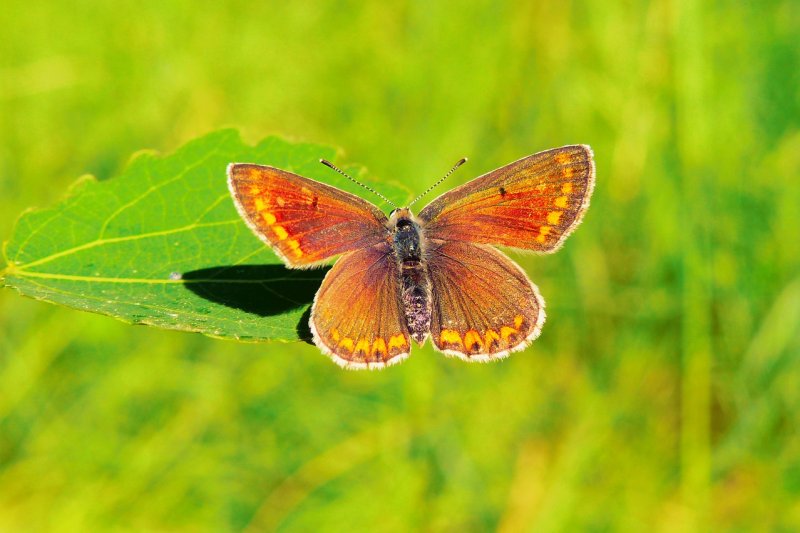
A study published Wednesday found that populations of insects, like this brown argus butterfly, have been cut by as much as half in some areas due to agriculture and climate change.
Photo by krzysztofniewolny/Pixabay
April 20 (UPI) -- Climate change and agriculture are threatening insect biodiversity, and in some areas have cut insect populations by half, according to a study published Wednesday.
The study, which appeared in the scientific journal Nature, found that rising temperatures and changes in the way land is used are linked to widespread drops in insect populations around the world.
A team from the University College London's Centre for Biodiversity and Environment Research analyzed nearly 20,000 insect species around the world.
They discovered that in regions with high-intensity agriculture and significantly warming climates, the number of insects was 49% lower than in habitats with no recorded climate change.
Impacted areas also experienced worsening biodiversity -- the number of insect species in those places were 29% lower than habitats with recorded climate change.
Insect populations in tropical ecosystems were hit the hardest by human influences, researchers found.
"Losing insect populations could be harmful not only to the natural environment, where insects often play key roles in local ecosystems, but it could also harm human health and food security, particularly with losses of pollinators," Dr. Charlie Outhwaite, the study's lead author and a research associate at UCL, told Science Daily.
"Our findings may only represent the tip of the iceberg as there is limited evidence in some areas, particularly in the tropics, which we found have quite high reductions in insect biodiversity in the most impacted areas."
In areas with low-intensity agriculture -- especially those with plenty of surrounding natural habitat -- losses to insect populations were much lower, researchers found.
Even in areas with rising temperatures, having at least three-fourths of the land occupied by natural habitat significantly buffered insect population decline.
In those areas, the number of insects dropped by only 7%, compared to a nearly two-thirds reduction in comparable areas with only one-fourth of natural habitat cover.
"The environmental harms of high-intensity agriculture present a tricky challenge as we try to keep up with food demands of a growing population," Dr. Tim Newbold, senior author and principal research fellow, told Science Daily.
He added that insect pollinators are especially vulnerable to agricultural expansion.
"Careful management of agricultural areas, such as preserving natural habitats near farmland, may help to ensure that vital insects can still thrive," Newbold said.
April 20 (UPI) -- Climate change and agriculture are threatening insect biodiversity, and in some areas have cut insect populations by half, according to a study published Wednesday.
The study, which appeared in the scientific journal Nature, found that rising temperatures and changes in the way land is used are linked to widespread drops in insect populations around the world.
A team from the University College London's Centre for Biodiversity and Environment Research analyzed nearly 20,000 insect species around the world.
They discovered that in regions with high-intensity agriculture and significantly warming climates, the number of insects was 49% lower than in habitats with no recorded climate change.
Impacted areas also experienced worsening biodiversity -- the number of insect species in those places were 29% lower than habitats with recorded climate change.
Insect populations in tropical ecosystems were hit the hardest by human influences, researchers found.
"Losing insect populations could be harmful not only to the natural environment, where insects often play key roles in local ecosystems, but it could also harm human health and food security, particularly with losses of pollinators," Dr. Charlie Outhwaite, the study's lead author and a research associate at UCL, told Science Daily.
"Our findings may only represent the tip of the iceberg as there is limited evidence in some areas, particularly in the tropics, which we found have quite high reductions in insect biodiversity in the most impacted areas."
In areas with low-intensity agriculture -- especially those with plenty of surrounding natural habitat -- losses to insect populations were much lower, researchers found.
Even in areas with rising temperatures, having at least three-fourths of the land occupied by natural habitat significantly buffered insect population decline.
In those areas, the number of insects dropped by only 7%, compared to a nearly two-thirds reduction in comparable areas with only one-fourth of natural habitat cover.
"The environmental harms of high-intensity agriculture present a tricky challenge as we try to keep up with food demands of a growing population," Dr. Tim Newbold, senior author and principal research fellow, told Science Daily.
He added that insect pollinators are especially vulnerable to agricultural expansion.
"Careful management of agricultural areas, such as preserving natural habitats near farmland, may help to ensure that vital insects can still thrive," Newbold said.
No comments:
Post a Comment